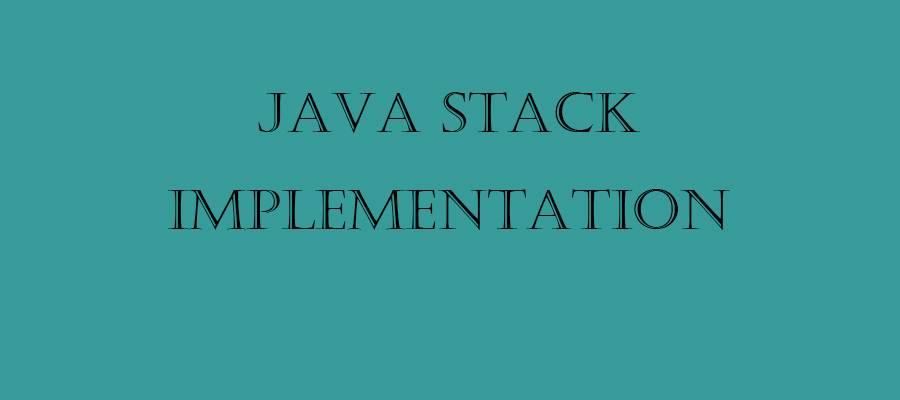关于Stack的几种实现

JAVA中堆栈的实现
- 不建议使用Stack类
//不建议使用原始栈的写法,已经out了
//Stack是JDK 1.0的产物,继承自 Vector,复用了大量vector的方法,底层还是数组,官方已经不推荐使用了
Stack<Integer> stack = new Stack<>();
stack.push(127);//入栈
stack.pop();//出栈
利用JAVA现有类
- ArrayDeque类
//简洁版本
Deque<Integer> stack = new ArrayDeque<>(32);
stack.addLast(127);//入栈
stack.removeLast();//出栈
//完整语义版本
Deque<String> stack = new ArrayDeque<>(32);
//入栈
stack.push("dave");
stack.push("dendy");
//出栈
stack.pop();
//取栈顶
stack.peek();
//语义通用部分
//取栈顶和栈底
stack.peekFirst();
stack.peekLast();
//包含与否
stack.cotains("dave");
//验空
stack.isEmpty();
//获取 容量
stack.size();
- LinkedList类
//简洁版本
Deque<Integer> stack = new LinkedList<>();
stack.addLast(127);//入栈
stack.removeLast();//出栈
//完整语义版本
Deque<String> stack = new LinkedList<>();
//入栈
stack.push("dave");
stack.push("dendy");
//出栈
stack.pop();
//取栈顶
stack.peek();
//包含与否
stack.cotains("dave");
//验空
stack.isEmpty();
//获取 容量
stack.size();
实现MyStack类
- Java在线工具
这部分直接可以在线验证,在线编译器参照如上
1.2.3.来自于Java 实现栈的三种方式,这里就直接搬运轮子了。
- 1.数组的方式实现
import java.util.Arrays;
/**
* 数组实现栈
* @param <T>
*/
class Mystack1<T> {
//实现栈的数组
private Object[] stack;
//数组大小
private int size;
Mystack1() {
stack = new Object[10];//初始容量为10
}
//判断是否为空
public boolean isEmpty() {
return size == 0;
}
//返回栈顶元素
public T peek() {
T t = null;
if (size > 0)
t = (T) stack[size - 1];
return t;
}
public void push(T t) {
expandCapacity(size + 1);
stack[size] = t;
size++;
}
//出栈
public T pop() {
T t = peek();
if (size > 0) {
stack[size - 1] = null;
size--;
}
return t;
}
//扩大容量
public void expandCapacity(int size) {
int len = stack.length;
if (size > len) {
size = size * 3 / 2 + 1;//每次扩大50%
stack = Arrays.copyOf(stack, size);
}
}
}
public class Main {
public static void main(String[] args) {
Mystack1<String> stack = new Mystack1<>();
System.out.println(stack.peek());
System.out.println(stack.isEmpty());
stack.push("java");
stack.push("is");
stack.push("beautiful");
stack.push("language");
System.out.println(stack.pop());
System.out.println(stack.isEmpty());
System.out.println(stack.peek());
}
}
/*
null
true
language
false
beautiful
*/
- 2.链表的方式实现
/**
* 链表实现栈
*
* @param <T>
*/
class Mystack2<T> {
//定义链表
class Node<T> {
private T t;
private Node next;
}
private Node<T> head;
//构造函数初始化头指针
Mystack2() {
head = null;
}
//入栈
public void push(T t) {
if (t == null) {
throw new NullPointerException("参数不能为空");
}
if (head == null) {
head = new Node<T>();
head.t = t;
head.next = null;
} else {
Node<T> temp = head;
head = new Node<>();
head.t = t;
head.next = temp;
}
}
//出栈
public T pop() {
T t = head.t;
head = head.next;
return t;
}
//栈顶元素
public T peek() {
T t = head.t;
return t;
}
//栈空
public boolean isEmpty() {
if (head == null)
return true;
else
return false;
}
}
public class Main {
public static void main(String[] args) {
Mystack2 stack = new Mystack2();
System.out.println(stack.isEmpty());
stack.push("Java");
stack.push("is");
stack.push("beautiful");
System.out.println(stack.peek());
System.out.println(stack.peek());
System.out.println(stack.pop());
System.out.println(stack.pop());
System.out.println(stack.isEmpty());
System.out.println(stack.pop());
System.out.println(stack.isEmpty());
}
}
/*
true
beautiful
beautiful
beautiful
is
false
Java
true
*/
- 3.LinkedList的方式实现
import java.util.LinkedList;
/**
* LinkedList实现栈
*
* @param <T>
*/
class ListStack<T> {
private LinkedList<T> ll = new LinkedList<>();
//入栈
public void push(T t) {
ll.addFirst(t);
}
//出栈
public T pop() {
return ll.removeFirst();
}
//栈顶元素
public T peek() {
T t = null;
//直接取元素会报异常,需要先判断是否为空
if (!ll.isEmpty())
t = ll.getFirst();
return t;
}
//栈空
public boolean isEmpty() {
return ll.isEmpty();
}
}
public class Main {
public static void main(String[] args) {
ListStack<String> stack = new ListStack();
System.out.println(stack.isEmpty());
System.out.println(stack.peek());
stack.push("java");
stack.push("is");
stack.push("beautiful");
System.out.println(stack.peek());
System.out.println(stack.pop());
System.out.println(stack.isEmpty());
System.out.println(stack.peek());
}
}
/*
true
null
beautiful
beautiful
false
is
*/
dave的补充
- 4.双端队列的方式实现[推荐]
import java.util.Deque;
import java.util.ArrayDeque;
/**
* 使用队列实现自定义堆栈
* 1、弹
* 2、压
* 3、获取头
* @author Administrator
*
* @param <E>
*/
class MyStack<E> {
//容器
private Deque<E> container=new ArrayDeque<E>();
private int cap=9;
public MyStack(int cap) {
super();
this.cap = cap;
}
//压栈
public boolean push(E e){
if(container.size()+1>cap){
return false;
}
return container.offerLast(e);
}
//弹栈
public E pop(){
return container.pollLast();
}
//获取
public E peek(){
return container.peekLast();
}
public int size(){
return this.container.size();
}
}
//测试自定义堆栈
public class Main{
/**
* @param args
*/
public static void main(String[] args) {
MyStack<String> nameBack =new MyStack<String>(32);
nameBack.push("dave");
nameBack.push("dendy");
nameBack.push("nora");
nameBack.push("cathy");
System.out.println("size:"+nameBack.size());
//遍历
String item=null;
while(null!=(item=nameBack.pop())){
System.out.println(item);
}
}
}
/*
size:4
cathy
nora
dendy
dave
*/
- 5.单向队列的方式实现[需要两个单向队列]
/*
1.现有两个队列 q1 和 q2,入栈则将元素加到 q1
2.出栈的时候先判读 q1 是否为空,因为 q1 中的元素总是后进来的,后进先出,
除了队列的最后一个元素,将其它元素添加到 q2,q1 的最后一个元素出队
3.出栈的时候如果在 2 中判断 q1 为空,除了 q2 的最后一个元素,
将 q2 中其它元素添加到 q1,然后 q2 中的最后一个元素出队
*/
import java.util.Queue;
import java.util.LinkedList;
/**
* 使用队列实现自定义堆栈
* 1、弹
* 2、压
* 3、获取头
* @author Administrator
*
* @param <E>
*/
class MyStack<E> {
//容器
private Queue<E> q1 = new LinkedList<E>();
private Queue<E> q2 = new LinkedList<E>();
public MyStack() {
}
public boolean push(E e) {
return q1.offer(e);
}
public E pop() {
if (q1.isEmpty() && q2.isEmpty()) {
return null;
}
// 先判断 q1 是否为空
if (!q1.isEmpty()) {
int size = q1.size();
for (int i = 0; i < size - 1; i++) {
q2.offer(q1.poll());
}
return q1.poll();
} else {
int size = q2.size();
for (int i = 0; i < size - 1; i++) {
q1.offer(q2.poll());
}
return q2.poll();
}
}
public int size() {
return q1.size() + q2.size();
}
}
//测试自定义堆栈
public class Main{
/**
* @param args
*/
public static void main(String[] args) {
MyStack<String> nameBack =new MyStack<String>();
nameBack.push("dave");
nameBack.push("dendy");
nameBack.push("nora");
nameBack.push("cathy");
System.out.println("size:"+nameBack.size());
//遍历
String item=null;
while(null!=(item=nameBack.pop())){
System.out.println(item);
}
}
}
/*
size:4
cathy
nora
dendy
dave
*/
说到两个单向队列实现一个堆栈,就不得不提一个队列的实现[需要两个栈]
/*
1.有两个栈 stack1 和 stack2
2.入队列的时候只往 stack1 添加元素就行
3.出队列的时候先判断 stack2 是否为空,stack2 中的元素都是先进来的,先进先出。
如果 stack2 不为空,则直接弹出 stack2 的栈顶元素。如果为空,则将 stack1 的
元素添加到 stack2 中,然后弹出 stack2 的栈顶元素
*/
import java.util.Queue;
import java.util.Stack;
/**
* 使用队列实现自定义堆栈
* 1、弹
* 2、压
* 3、获取头
* @author Administrator
*
* @param <E>
*/
class MyQueue<E> {
//容器
private Stack<E> stack1 = new Stack<E>();
private Stack<E> stack2 = new Stack<E>();
/**
* 添加元素到队列
*
* @param num
* @return
*/
public E offer(E e) {
return stack1.push(e);
}
/**
* 队列弹出元素
*
* @return
*/
public E poll() {
if (stack1.isEmpty() && stack2.isEmpty()) {
return null;
}
// 先判断 stack2
if (!stack2.isEmpty()) {
return stack2.pop();
}
// 将 stack1 的元素放入 stack2
int size = stack1.size();
for (int i = 0; i < size; i++) {
stack2.push(stack1.pop());
}
return stack2.pop();
}
public int size() {
return stack1.size() + stack2.size();
}
}
//测试自定义队列
public class Main{
/**
* @param args
*/
public static void main(String[] args) {
MyQueue<String> nameBack =new MyQueue<String>();
nameBack.offer("dave");
nameBack.offer("dendy");
nameBack.offer("nora");
nameBack.offer("cathy");
System.out.println("size:"+nameBack.size());
//遍历
String item=null;
while(null!=(item=nameBack.poll())){
System.out.println(item);
}
}
}
/*
size:4
dave
dendy
nora
cathy
*/

